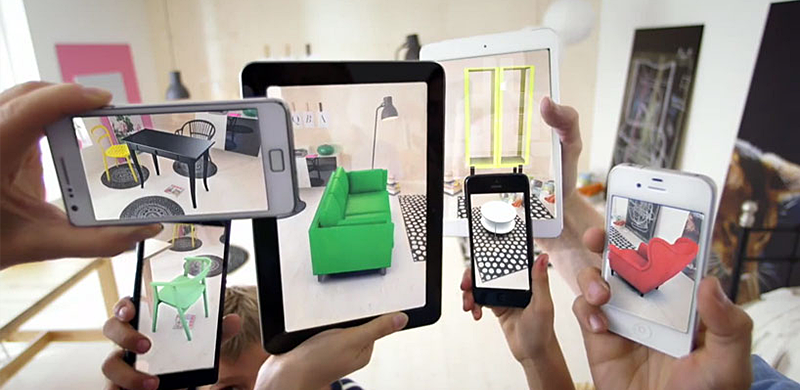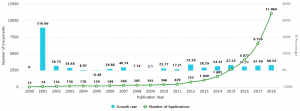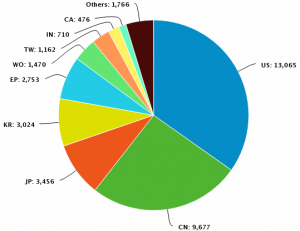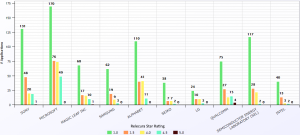
Augmented Reality (AR) has grown in popularity in recent years due to the way it enhances the real world by bringing in the elements of the virtual world. AR is created when computer-generated text or images are superimposed in our view of the real world. The widely used filters on social media and apps such as Animoji, an Apple iOS feature, that mashes a user’s facial expressions with virtual animal faces, are some examples of AR technology.
AR has found its way into various applications across industries. Alphabet Inc.’s Google Glass is used by manufacturing, logistics and healthcare companies where the personnel can view schematics and instructions as they work. Microsoft won a military contract with the US Army in 2018 to produce an AR platform based on its HoloLens headset. Some AR solutions enable consumers to visualize products or experience the service before purchasing them.
Samsung recently patented specialized contact lenses with a hidden built-in camera. Samsung’s contact lenses are primarily designed for realizing augmented reality. In this report, we provide updated trends and insights into patents related to AR technology that we first covered here.
General Trends
The augmented reality market is expected to reach USD 60.55 billion by 2023, growing at a CAGR of 40.29% during the forecast period of 2018 to 2023. The published applications related to AR technology also show an accelerated growth year-on-year, with a significant upward trend beginning around 2011-2012, as seen in Figure 1.
Figure 2 shows that the U.S. leads in terms of the maximum number of published applications followed by China. These leading jurisdictions are followed by Japan, Korea and the European Patent Office.
According to a report published by the International Data Corporation (IDC), China’s market spending on augmented reality and virtual reality (VR/AR) will exceed $65.21 billion in 2023. China-based funding for companies working in augmented reality and computer vision technologies rose to $3.9 billion over the last 12 months, surging ahead of the quantum of similar North American investment, according to Digi-Capital.
Figure 3 shows the growth for published applications in key jurisdictions from 2014. The rate of growth of the published applications in the key jurisdictions suggests that China is poised to overtake the U.S. in the number of published applications related to Augmented Reality in the next few years. The number of published applications in the other jurisdictions are not growing at the same rate as the U.S. and China, indicating that the U.S. and China will remain the leaders in this space for the next few years.
Technology Trends
The AR industry continues to expand beyond gaming into smartphones, cars and other applications.
AR patents typically claim hardware, software, or a combination of both. Hardware usually includes display screens, head-mounted devices, helmets, glasses and similar devices, while software may consist of computing methods required to generate digital environments.
The top sub-technologies covered by the Augmented Reality patents relate to the software aspects of image analysis and recognition and computer graphics as well as hardware and devices. Of these sub-technologies, patents addressing devices have shown a significant growth in the 2014-2018 period.
Figure 4 shows the high quality patents for the top patent holders related to AR technologies. High value patents are the ones with a Relecura Star rating 3.0 or above. The Relecura Star rating ranks each patent on a scale of five. It is a proprietary composite metric incorporating multiple criteria. The metric combines the different technology, business, and litigation related factors. Generally, a patent that scores three or more out of five in terms of the Star Rating is deemed as a “high value” patent.
All the top patent holders have high quality patents addressing Augmented Reality patents in their portfolios. Of the leaders, Microsoft seems to have an edge in the number of high-quality patents held, addressing this technology area.
A technology category-wise comparison of the portfolios of the top players shows that both Sony and Microsoft have patent coverage across many of the technology categories related to Augmented Reality.
In this regard, they are joined by Magic Leap Inc., whose portfolio also displays good coverage across the various related technology categories. Magic Leap hit the headlines recently with its AR technology being used by the US Navy for training their teams using an immersive training system that provides realistic scenarios for sailors. The company also launched its new AR app called Undersea that generates a coral reef environment in real time. Read our report to stay updated on various trends related to different aspects of AR related technologies.













